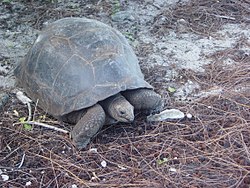Aldabra is a ![]() UNESCO World Heritage Site in the Outer Seychelles and the world's second-largest coral atoll.
UNESCO World Heritage Site in the Outer Seychelles and the world's second-largest coral atoll.
Understand
[edit]
History
[edit]The name Aldabra (originally Al-Hadra or Al-Khadra) was given by Arab seafarers for "the atoll’s harsh, sun-baked environment". In the middle of the 18th century, the atoll became a dependency of the French colony of Réunion, from where expeditions were made for the capture of the Aldabra giant tortoises. As there are no surface freshwater sources on Aldabra, the interests of the explorers was merely to exploit the species of tortoise, turtle and fish, and not to inhabit the atoll. Sailors landed on the atoll in the 19th century and captured tortoises as food. Despite a ban on the killing of tortoises enacted in 1891, by 1900 the tortoises were nearly extinct. In 1888, the first settlement was established on Picard Island facing west near the beach. A two-room jail was built on the island, the remnants of which can be seen today.
Following World War II, the atoll became part of the British Indian Ocean Territory in 1965. This lasted until the Seychelles' independence in 1976. The British intended to establish a military base on the atoll, but instead built the base on Diego Garcia of the Chagos Islands. Scientific interest in the atoll grew, with the Royal Society of London establishing a research station in 1970. After the Society left in 1979, the administration of the atoll was turned over to the Seychelles Island Foundation (SIF), which declared the atoll a Special Nature reserve in 1981 and then a UNESCO World Heritage Site in 1982. A small research station of the SIF is based in La Gigi village on Picard Island. The permanent staff are the atoll's only inhabitants.
Landscape
[edit]The atoll is the largest raised coral reef in the world with an elevation of 8 metres (26 ft) and is the second-largest atoll in the world after Kiritimati. It consists of four large islands plus some 40 smaller islands and rocks lying within a 380-square-kilometre (150 sq mi) lagoon. There are also a few small islands lying within the channels between the larger islands.
Flora and fauna
[edit]
The higher areas of Aldabra are covered in pemphis, a thick coastal shrub, while the lower areas, home to the giant tortoises, are a mixture of trees, shrubs, herbs and grasses. There have been recorded 273 species of flowering plants, shrubs, and ferns on the atoll. The lagoon is bordered by mangrove forests, and has large inland seagrass meadows as well as areas of coral reef and sand flats.
The atoll has distinctive fauna including the largest population of giant tortoises in the world (100,000 animals). Aldabra is also a breeding ground for the hawksbill sea turtle and green sea turtle. It has a large population of the world's largest terrestrial arthropod, the coconut crab, and hosts the white-throated rail, the only surviving flightless rail species in the Indian Ocean. Sharks, manta rays, and barracuda populate the seas surrounding the island. Dolphins, orcas, dudongs and humpback whales are also seen in the waters.
Endemic birds include the Aldabra drongo, the Aldabran subspecies of the white-throated rail, the last surviving flightless bird of the Indian Ocean region, and the endemic Aldabra fody. The islands are important breeding grounds for thousands of seabirds, including several species of tern, red-tailed tropicbirds, white-tailed tropicbirds, red-footed boobies, and the world's second largest breeding populations of great and lesser frigate birds. The bird fauna is most similar to Madagascar or Comoros, and other birds found here include greater flamingos, the Malagasy pond heron, Comoros blue pigeon, Malagasy kestrel, Malagasy coucal, Madagascar nightjar, Malagasy bulbul and souimanga sunbird.
Climate
[edit]Aldabra is situated in the dry zone of the south-west Indian Ocean. The northwest monsoon season is from November to March and brings the heaviest rainfall. In the remaining months, the south-easterly trade winds are dominant. Aldabra receives an annual average rainfall of 960 mm (38 in). The monthly mean maximum air temperature recorded in December is 31 °C (88 °F) while the mean minimum temperature recorded in August is 22 °C (72 °F).
Get in
[edit]
Aldabra is not easily accessed. No airstrips, helipads or landing jetties have been permitted on the atoll. The nearest airfield is on Assumption Island, 50 kilometres (31 mi) to the southeast. There are no tourist facilities. However, cruises are operated by several companies, which are easily searchable online. If you're lucky, you may even be able to go ashore. Dive boats also visit the island.
Fees and permits
[edit]To visit the island, you must obtain a permit from the Seychelles Island Foundation.
Get around
[edit]There are walking paths on Picard Island, one of which leads up to a small viewpoint.
Do
[edit]- Wildlife viewing, especially the turtles and tortoises
- Diving
- Snorkeling
